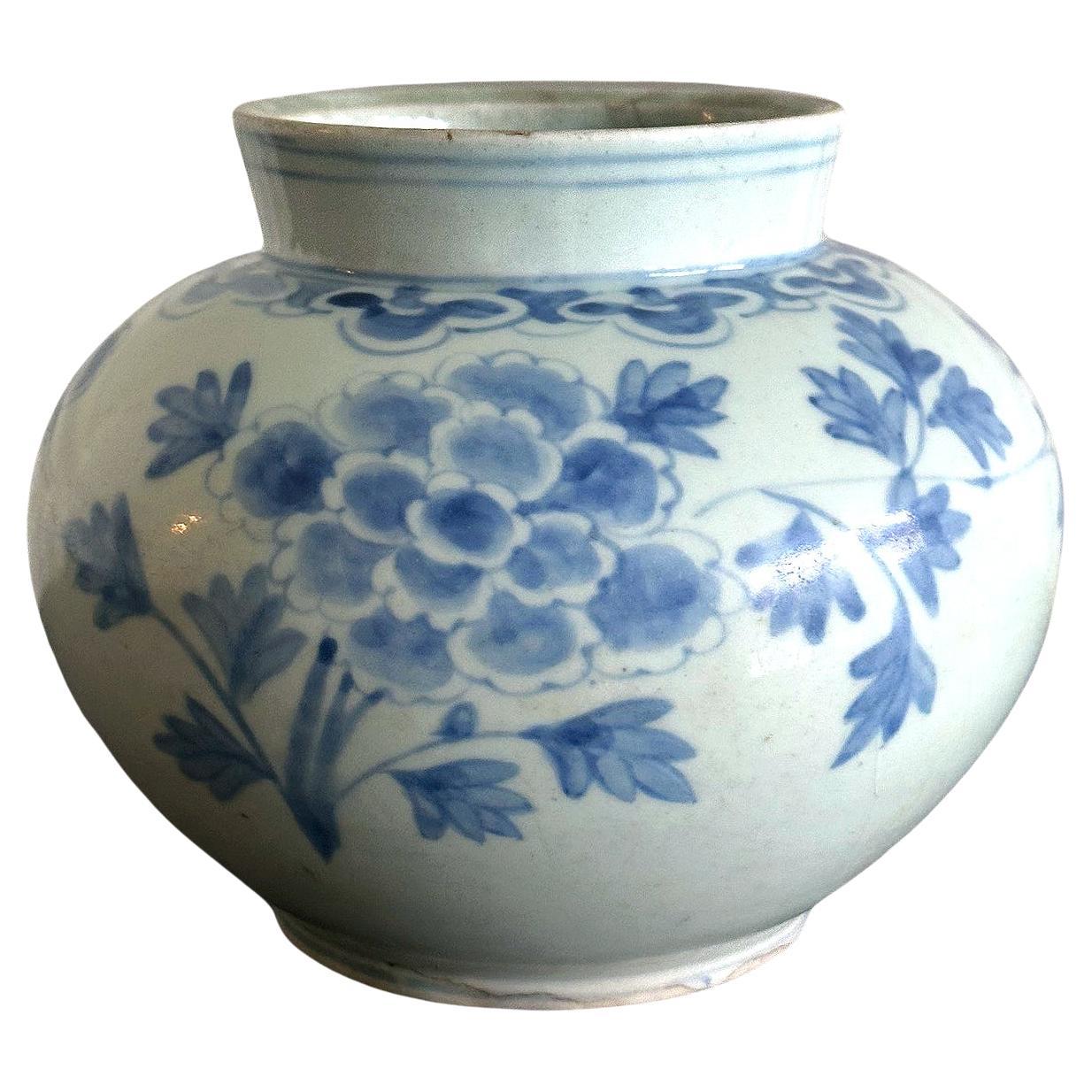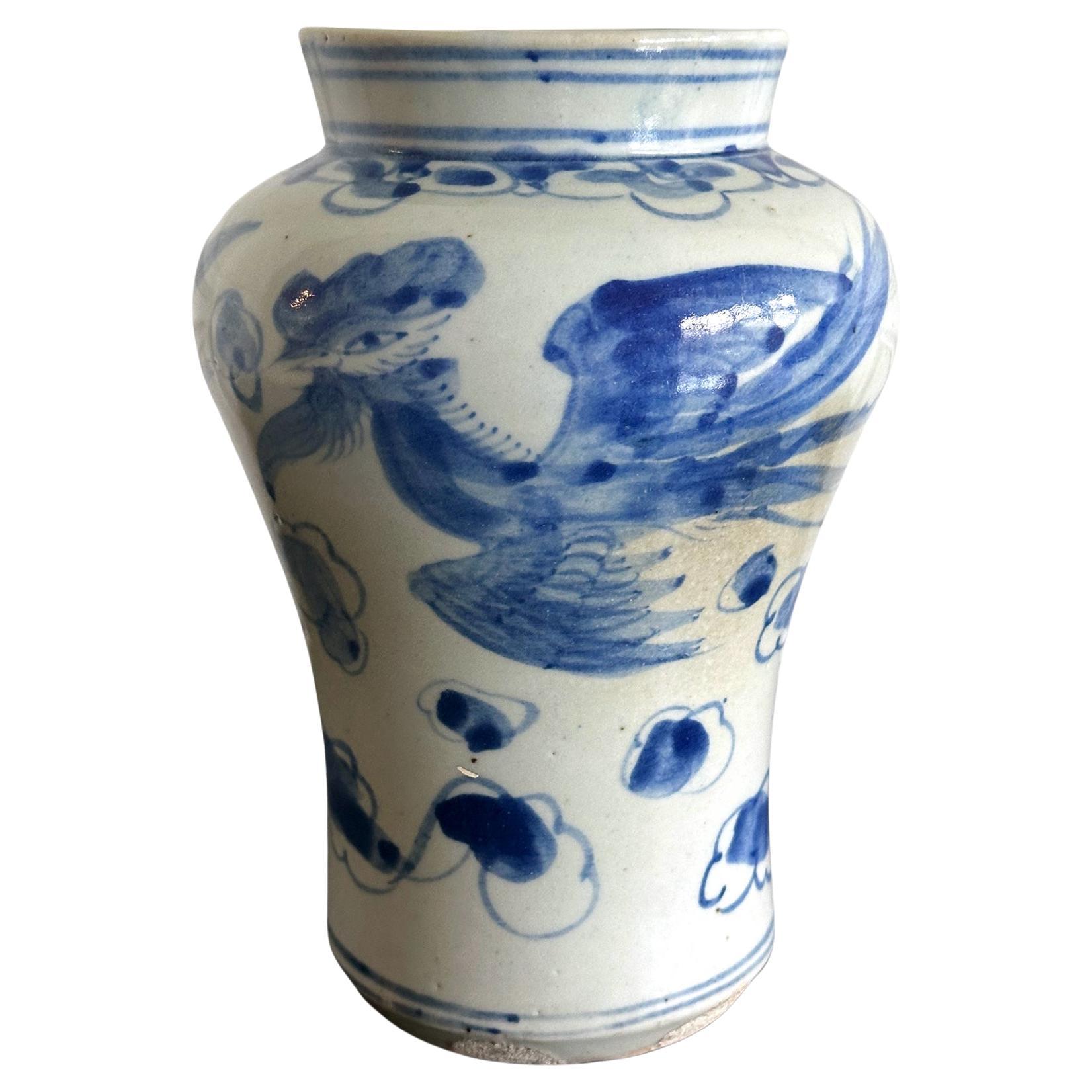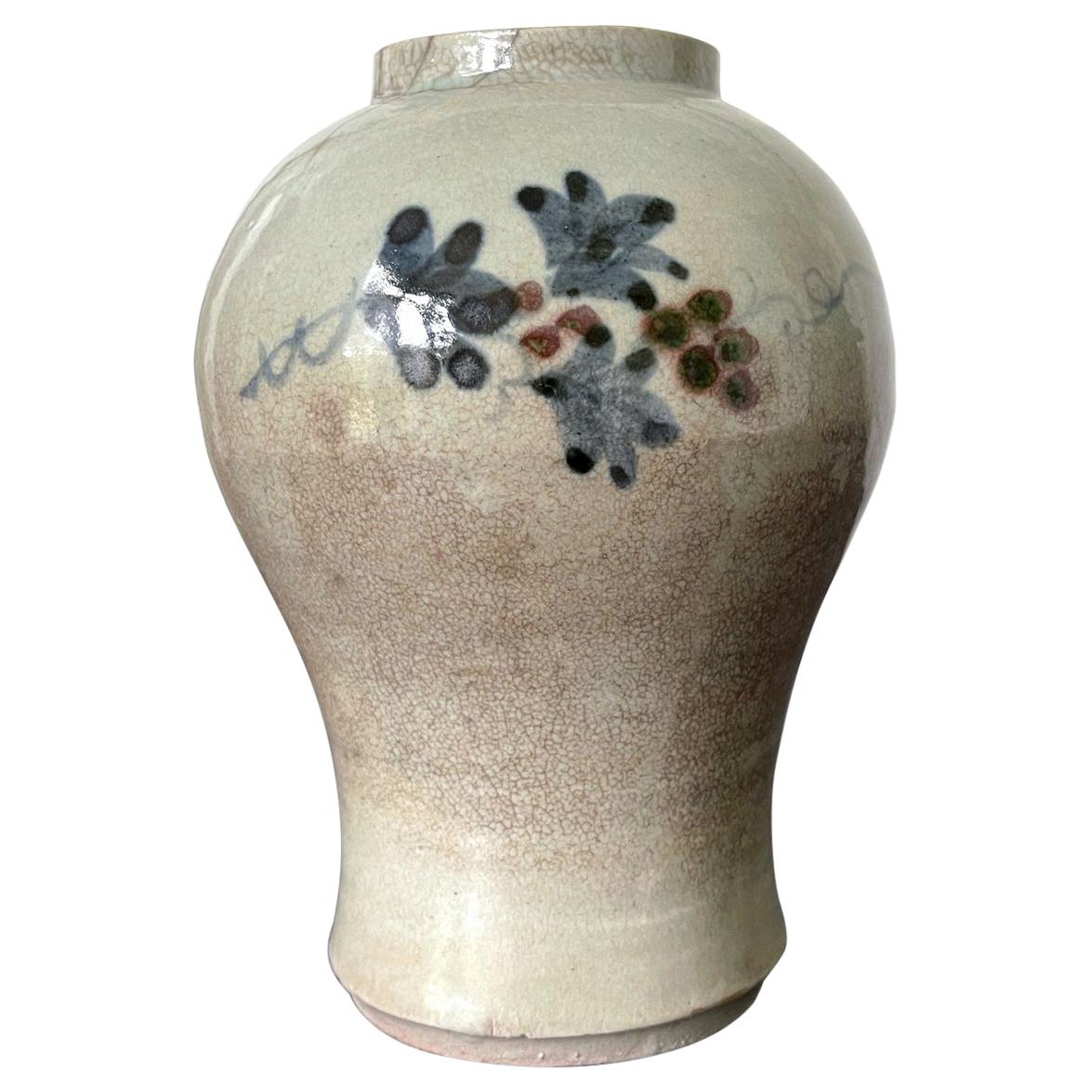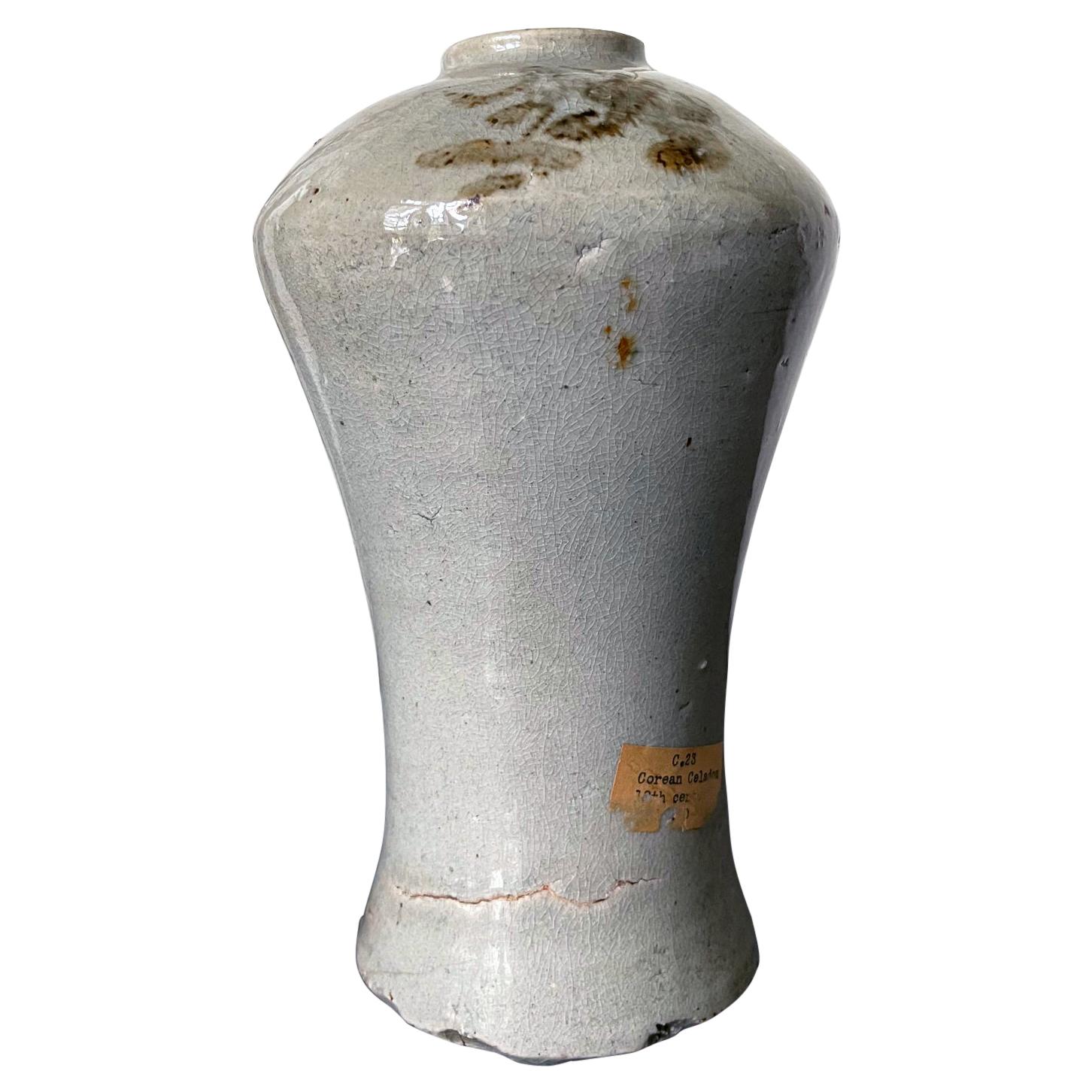Items Similar to Antique Korean Porcelain Peony Jar Joseon Dynasty
Want more images or videos?
Request additional images or videos from the seller
1 of 18
Antique Korean Porcelain Peony Jar Joseon Dynasty
About the Item
A Korean white porcelain jar with underglaze blue painting of large peonies with leaves circa second half of 19th century, Joseon Dynasty. Considered associated with Punwon-ri kilns in Gwangju, these types of globular jar with large mouth on a short near-straight neck were known as Tanji and used in the kitchen such as for pickling. The shape follows the function. Traditionally, they were made in three sizes with this jar being the medium size. The conforming foot ring and the slightly everted neck allow them to be stacked. The underglaze blue decoration tends to be rustic and folky. Peony flower was one of the most beloved motifs. The shoulder was decorated with the scrolling youi-head and the neck circumvented with lines.
As vernacular objects in the household, these jars tend to see a lot of handling and almost always show patina, stains, small nicks and chips, as evidence from use, part of their history.
For a similar pickle jar with peony design, see item c.442 dash 1984 in the Gompertz Collection in the Fitzwilliam Musuem, Cambridge. Illustration 191 on page 289 of the Musuem Publication "Korean Art, A complete Catalogue" by Tong-i.
For another comparable jars, see item 2006-826 in the collection of Princeton University Art Museum.
Item 2015.79.504 a,b in the Mary Griggs Burke Collection in Minneapolis Institute of Art
- Dimensions:Height: 5.25 in (13.34 cm)Diameter: 6 in (15.24 cm)
- Style:Other (Of the Period)
- Materials and Techniques:Porcelain,Glazed
- Place of Origin:
- Period:
- Date of Manufacture:19th century
- Condition:Wear consistent with age and use. General patina associated with age and use. A couple of minute nicks on the rim. Scattered firing marks. Kiln grits and small nicks along the foot ring, all as shown.
- Seller Location:Atlanta, GA
- Reference Number:1stDibs: LU945038686492
About the Seller
5.0
Platinum Seller
These expertly vetted sellers are 1stDibs' most experienced sellers and are rated highest by our customers.
Established in 2006
1stDibs seller since 2010
479 sales on 1stDibs
Typical response time: <1 hour
- ShippingRetrieving quote...Ships From: Atlanta, GA
- Return PolicyA return for this item may be initiated within 2 days of delivery.
More From This SellerView All
- Antique Korean Porcelain Peony Jar Joseon DynastyLocated in Atlanta, GAA Korean white porcelain jar with underglaze blue painting of large peonies with leaves circa second half of 19th century, Joseon Dynasty. Considered associated with Punwon-ri kilns ...Category
Antique Late 19th Century Korean Other Ceramics
MaterialsPorcelain
- Antique Korean Porcelain Jar with Pheonix Design Joseon DynastyLocated in Atlanta, GAA korean white porcelain jar with underglaze blue paint circa late 19th century toward the end of Joseon Dynasty. Porcelain jars of this elongated form with swell shoulder, wide mout...Category
Antique Late 19th Century Other Ceramics
MaterialsPorcelain
- Korean Ceramic Storage Jar Joseon DynastyLocated in Atlanta, GAA Korean ceramic storage jar circa 18th century of Joseon Dynasty. The jar is of a characteristic form with a bulbous upper body that tappers with a gra...Category
Antique 18th Century Korean Other Ceramics
MaterialsCeramic
- Fine Korean Porcelain Jar with Chrysanthemum Design Joseon DynastyLocated in Atlanta, GAA fine Korean white porcelain jar with underglaze blue painting circa second half of 19th century, Joseon Dynasty. Considered associated with Punwon-ri kilns in Gwangju, these types ...Category
Antique Late 19th Century Korean Other Ceramics
MaterialsPorcelain
- Tall Korean Ceramic Storage Jar Joseon DynastyLocated in Atlanta, GAA Korean ceramic storage jar circa 18th century of Joseon Dynasty. The jar is of a classic Maebyong form (known in Chinese as Plum Vase or Meiping...Category
Antique 18th Century Korean Other Ceramics
MaterialsCeramic
- Faceted Korean Ceramic Celadon Jar Joseon DynastyLocated in Atlanta, GAA small ceramic celadon storage jar circa 18th century of Korean Joseon Dynasty. The melon shape jar with a mouth and base of the same size display a beautiful harmony in its form. T...Category
Antique 18th Century Korean Other Ceramics
MaterialsCeramic
You May Also Like
- Korean White Glazed Jar, Joseon Dynasty, 18th Century, KoreaLocated in Austin, TXA sublime Korean white glazed porcelain globular jar, Joseon Dynasty, 18th century, Korea. The squat jar is heavily potted, with a globular body, very short neck, and wide mouth r...Category
Antique 18th Century Korean Ceramics
MaterialsPorcelain
- Moon Jar / Korean Antique vase / Joseon Dynasty / 18th CenturyLocated in Kyoto-shi, KyotoIt's a wonderful moon jar. It is a rare size that is suitable for the alcove of a Japanese tea room. It is shaped at once without connecting the uppe...Category
Antique 18th Century Korean Antiquities
MaterialsCeramic
- White Porcelain Vase / 17th Century / Korean Antiques / Joseon DynastyLocated in Kyoto-shi, KyotoThis product is a white porcelain bottle from the Joseon Dynasty. People in those days used bottles like this to make soap from waste oil. With use, the porcelain frayed and curle...Category
Antique 17th Century Antiquities
MaterialsCeramic, Porcelain
- Moon Jar 'Dalhanari', Lot3 / 17th Century / Korean Antiques / Joseon DynastyLocated in Kyoto-shi, KyotoThis is a white porcelain jar from the mid-Joseon period, also known as a "Talhunari" or "moon jar". During the Joseon Dynasty, which was strongly influenced by Confucianism, the purity of white porcelain was particularly prized in its artistic expression due to its Confucian sensitivity. The defining characteristic of white porcelain during this period was its pure white color, but there were many subtle variations in the white hues, with some being classified as milky white, snowy white, ashen white, and bluish white. The term "Talhunari" means "moon jar" in Korean, and it refers to the large, round shape of the jar, resembling a full moon. It was named by Kim Whanki, a representative abstract painter of Korea. The soft, curving lines and sturdy body that seems to embrace the full moon give the jar both power and tranquility. This type of jar was produced in large quantities during the 17th century. The white of the moon jar is not the pure white of early Joseon porcelain...Category
Antique 17th Century Korean Ceramics
MaterialsCeramic, Porcelain
- Moon Jar 'Dalhanari' - Lot2 / 17th Century / Korean Antiques / Joseon DynastyLocated in Kyoto-shi, KyotoThis is a white porcelain jar from the mid-Joseon period, also known as a "Talhunari" or "moon jar". During the Joseon Dynasty, which was strongly influenced by Confucianism, the purity of white porcelain was particularly prized in its artistic expression due to its Confucian sensitivity. The defining characteristic of white porcelain during this period was its pure white color, but there were many subtle variations in the white hues, with some being classified as milky white, snowy white, ashen white, and bluish white. The term "Talhunari" means "moon jar" in Korean, and it refers to the large, round shape of the jar, resembling a full moon. It was named by Kim Whanki, a representative abstract painter of Korea. The soft, curving lines and sturdy body that seems to embrace the full moon give the jar both power and tranquility. This type of jar was produced in large quantities during the 17th century. The white of the moon jar is not the pure white of early Joseon porcelain...Category
Antique 17th Century Korean Antiquities
MaterialsCeramic, Porcelain
- White Porcelain Incense Burner / Korean Antique / Joseon Dynasty/1392 - 1897 CELocated in Kyoto-shi, KyotoThis incense burner presents the characteristics of a typical Yi Dynasty Joseon Dynasty incense burner with a body that rises smoothly from the base, openworked ears and a semi-circu...Category
Antique 17th Century Korean Antiquities
MaterialsCeramic
Recently Viewed
View AllMore Ways To Browse
Export Quality Enameled
Ming Celadon Bowl
Asian Style Temple Jars
Hibachi Pottery
Blue White Arita Charger
Bouddha Ceramic
Aoki Mokubei
Antique Sake Stoneware
Chinese Aquarium
Chinese Cong Vase
Chinese Foo Dog Plates
Chinese Ming Bowl Export Trade
Chinese Peachbloom Porcelain
Coral Foo Dog
Dragon Egg Pot
Jade Circle Decoration
Ko Kutani Arita
Meiji Yamatoku





